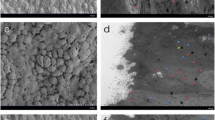Abstract
The control of complement activation in the embryo–maternal environment has been demonstrated to be critical for embryo survival. Complement proteins are expressed in the human endometrium; however, the modulation of this expression by embryo signals has not been explored. To assess the expression of complement proteins in response to human chorionic gonadotropin (hCG), we designed an experimental study using in vivo and in vitro models. Twelve fertile women were treated with hCG or left untreated during the mid-luteal phase, and an endometrial biopsy was performed 24 hours later. The localizations of C3, membrane cofactor protein (MCP; CD46), decay-accelerating factor (DAF; CD55), and protectin (CD59) were assessed by immunohistochemistry, and the messenger RNA (mRNA) levels of these proteins were quantified by real-time reverse transcriptase–polymerase chain reaction (RT-PCR) in cells harvested from endometrial compartments using laser capture microdissection. Endometrial explants were cultured with or without hCG for 24 hours, and the C3 and DAF protein levels were measured by Western blotting. Elevated C3 mRNA levels in stromal cells and elevated DAF levels in epithelial luminal cells were detected after hCG treatment. In the endometrial explant model, the progesterone receptor antagonist RU486 inhibited the increases in the levels of C3 and DAF in response to hCG. The findings of this study indicate that hCG plays a role in embryo–endometrium communication and affects the expression of complement proteins in endometrial compartments during the implantation window.
Similar content being viewed by others
References
Lessey BA. Endometrial receptivity and the window of implantation. Baillieres Best Pract Res Clin Obstet Gynaecol. 2000;14(5): 775–788.
Diedrich K, Fauser BC, Devroey P, Griesinger G. Evian annual reproduction (EVAR) workshop group.The role of the endometrium and embryo in human implantation. Hum Reprod Update. 2007;13(4):365–377.
Bulla R, Fischetti F, Bossi F, Tedesco F. Feto-maternal immune interaction at the placental level. Lupus. 2004;13(9):625–629.
Lobo SC, Huang ST, Germeyer A, et al. The immune environment in human endometrium during the window of implantation. Am J Reprod Immunol. 2004;52(4):244–251.
Murray KP, Mathure S, Kaul R, et al. Expression of complement regulatory proteins CD35, CD46, CD55 and CD 59 in benign and malignant endometrial tissue. Gynecol Oncol. 2000;76(2): 176–182.
Xu C, Mao D, Holers VM, Palanca B, Cheng AM, Molina H. A critical role for murine complement regulator Crry in fetomaternal tolerance. Science. 2000;287(5452):498–501.
Sayegh RA, Tao XJ, Awward JT, Isaacson KB. Localization of the expression of complement C3 in endometrium by in situ hybridization. J Clin Endocrinol Metab. 1996;81:1641–1649.
Hasty LA, Lambris JD, Lessey BA, Pruksananonda K, Lyttle CR. Hormonal regulation of complement components and receptors through the menstrual cycle. Am J Obstet Gynecol. 1994;170(1 pt 1):168–175.
Nogawa Fonzar-Marana RR, Ferriani RA, Soares SG, Cavalcante-Neto FF, Teixeira JE, Barbosa JE. Expression of complement system regulatory molecules in the endometrium of normal ovulatory and hyperstimulated women correlate with menstrual cycle phase. Fertil Steril. 2006;86(3):758–761.
Sherwin JR, Sharkey AM, Cameo P, et al. Identification of novel genes regulated by chorionic gonadotropin in baboon endometrium during the window of implantation. Endocrinology. 2007; 148(2):618–626.
Sherwin JR, Hastings JM, Jackson KS, Mavrogianis PA, Sharkey AM, Fazleabas AT. The endometrial response to chorionic gonadotropin is blunted in a baboon model of endometriosis. Endocrinology. 2010;151(10):4982–4993.
Licht P, Von Wolff M, Berkholz A, Wildt L. Evidence for cycle-dependent expression of full-length human chorionic gonadotropin/luteinizing hormone receptor mRNA in human endometrium and deciduas. Fertil Steril. 2003;79 (1):718–723.
Fazleabas AT, Kim JJ, Strakova Z. Implantation: embryonic signals and the modulation of the uterine environment-A review. Placenta. 2004;(25 suppl A):S26–S31.
Licht P, Russu V, Wildt L. On the role of human chorionic gonadotropin (hCG) in the embryo-endometrial microenvironment: implications for differentiation and implantation. Semin Reprod Med. 2001;19(1):37–47.
Lovely LP, Fazleabas AT, Fritz MA, McAdams DG, Lessey BA. Prevention of endometrial apoptosis: randomized prospective comparison of human chorionic gonadotropin versus progesterone treatment in the luteal phase. J Clin Endocrinol Metab. 2005;90(4):2351–2356.
Kohen P, Castro O, Palomino A, et al. The steroidogenic response and corpus luteum expression of the steroidogenic acute regulatory protein after human chorionic gonadotropin administration at different times in the human luteal phase. J Clin Endocrinol Metab. 2003;88(7):3421–3430.
Noyes RW, Hertig AT, Rock J. Dating the endometrial biopsy. Fertil Steril. 1975;122(2):262–263.
Palomino WA, Kohen P, Devoto L. A single midcycle dose of Levonorgestrel similar to emergency contraceptive does not alter the expression of the L-selectin ligand or molecular markers of endometrial receptivity. Fertil Steril. 2010;94(5): 1589–1594.
Fogle RH, Aimin L, Paulson RJ. Modulation of Hoxa 10 and other markers of endometrial receptivity by age and human chorionic gonadotropin in an endometrial explant model. Fertil Steril. 2010;93(4):1255–1259.
Francis J, Rai R, Sebire NJ, et al. Impaired expression of endometrial differentiation markers and complement regulatory proteins in patients with recurrent pregnancy loss associated with antiphospholipid syndrome. Mol Hum Reprod. 2006;12(7):435–442.
Goldsby RA, Kindt TJ, Osborne BA. Kuby Immunology. 4th ed. New York, NY: W.H. Freeman and Company; 2000.
Franchi A, Zaret J, Zhang X, Bocca S, Oehninger S. Expression of immunomodulatory genes, their protein products and specific ligands/receptors during the window of implantation in the human endometrium. Mol Hum Reprod. 2008;14(7):413–421.
Young SL, Lessey BA, Fritz MA, et al.. In vivo and in vitro evidence suggest that HB-EGF regulates endometrial expression of human decay accelerating factor. J Clin Endocrinol Metab. 2002;87(3):1368–1375.
Torres MST, Ace CI, Okulicks WC. Assessment and application of laser microdissection for analysis of gene expression in the rhesus monkey endometrium. Biol Reprod. 2002;67(4):1067–1072.
Yanaihara A, Otsuka Y, Iwasaki S, et al.. Comparison in gene expression of secretory human endometrium using microdissection. Reprod Biol Endocrinol. 2004;2(17):66.
Banerjee P, Fazleabas AT. Endometrial responses to embryonic signals in the primate. Int J Dev Biol. 2010;54(2–3):295–3002.
Author information
Authors and Affiliations
Corresponding author
Rights and permissions
About this article
Cite this article
Palomino, W.A., Argandoña, F., Azúa, R. et al. Complement C3 and Decay-Accelerating Factor Expression Levels Are Modulated by Human Chorionic Gonadotropin in Endometrial Compartments During the Implantation Window. Reprod. Sci. 20, 1103–1110 (2013). https://doi.org/10.1177/1933719113477486
Published:
Issue Date:
DOI: https://doi.org/10.1177/1933719113477486




